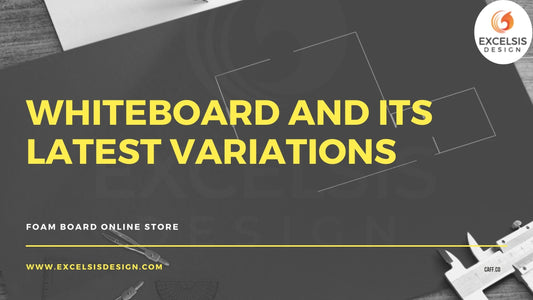Introduction
This article is a take on the concept of foam boards. It includes the different types of foam boards and their various benefits/uses in the market. The product features in the post will be an eye-opener in determining the one that matches your requirement. Foam boards ideally involve multiple types based on their size, shape, color, fit, and usage.
What Are Foam Boards?
Foam boards are also known as foam core boards & are a sturdy and lightweight material that can be cut easily with a sharp craft knife or a mat cutter for picture framing. It's often used for mounting prints and photographs, as well as as a picture frame backing. Foam Board may be easily shaped into shapes for interior design and architectural projects.
Foam board is often made up of three layers: an inner layer of polystyrene or polyurethane foam, a white clay coated paper, cotton archival paper or brown Kraft paper, and an outside layer of either of them.
Types of Foam Boards
The main types of foam boards are black foam core and black form core. Blackcore Foam Board is similar to conventional foam board, but it has a black foam core & is laminated on both sides with black, coated paper stock. It creates a striking backdrop for signs and exhibitions.
The black form core works better when creating something spectacular, and your presentation has to stand out. It is ideal for anything from business presentations, school exhibitions, and craft displays. It is an economical product available in the market to suit various operations in a customer-friendly way.
Naturally, they are lightweight, durable, and are perfect for projects, signs, presentations, and crafts. They can work on smooth surfaces like paints, varnishes, adhesives, and markers.
Monsanto has been producing Foam-Core® foam core boards in 1/8 inch (3 mm) and 3/16 inch (5 mm) thicknesses since 1957. It's currently a common picture framing background, with archival-quality varieties available from numerous manufacturers. Thicknesses ranging from 3mm to 10mm are widely available, with a 20mm variant available for big displays and art hanging.
Other foam-cored materials with a cladding of solid styrene or other hard plastic coating are sold under various brand names. These are excellent for signage and other circumstances that necessitate stiffness. Naturally, a panel saw is used to cut these boards.
Some specialized boards include an aluminum front to enable the mounting of high-gloss photographic prints, while others have fire retardants for usage in museums. When it comes to mounting goods, self-adhesive foam boards can be harsh. After you have mounted your photograph or printed it onto a self-adhesive foamboard, you should give some curing time where you maintain the mounted work flat to ensure it does not distort before you arrange the image in a picture frame.
Use plain foam board for temporary installation and repositionable spray adhesive on one of the surfaces, either the back of the image or the board face.
Features & Benefits
The primary benefits and features common to all types of foam boards that include black form core boards are given below.
- Water resistance.
- Corrosion resistance.
- Fire resistance.
- High strength.
- Durability.
- Easily shaped.
- Painted & colored.
- Pocket-friendly.
- Foam boards can be great in the ceilings of cars, trains, or buses.
- They find applications in home & office furniture.
- The foam boards are possible to build external wall panels.
- You can design home interiors using PVC foam boards.
- They can be available in signboards and outdoor advertising kiosks.
- Foam boards are good in sectors like construction, garage doors, POP displays, exhibit spaces, and signage.
Conclusion
Foam boards are a great design concept, and over the years, they have not lost their value. Contrary to the notion of saturation of methods and products within a time, foam boards are here to stay. They are impressively holding their ground in the respective industries and domains needing their involvement.




